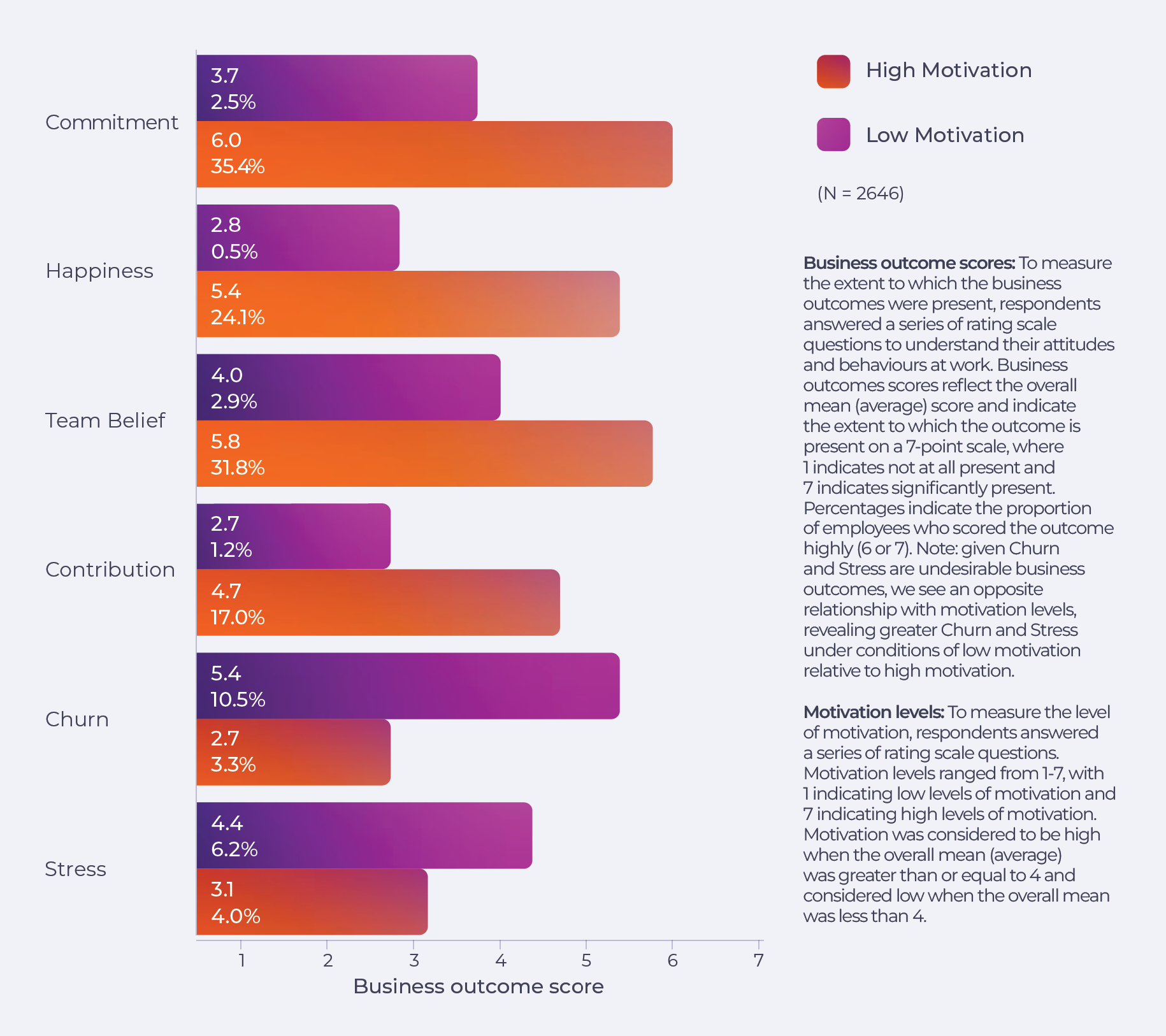Why is motivation important?
We all talk a lot about motivation. We all instinctively know it’s important for our teams to be motivated at work; we believe more will get done and to a higher quality, with fewer risks of anything breaking along the way. And we all know what it feels like when we have no motivation to go to work—things become sluggish to say the least.
However, while we recognize the importance of motivation, we’re not particularly good at actually quantifying why and how it’s important, and this is problematic. The science tells us motivation is key for anything to happen. No motivation—no action. We can think of motivation as both the engine to our behavior and the oil that keeps that engine running smoothly. Many organizations see high motivation as a “soft supplement” to organizational performance; something that is important, but also optional and poorly defined. We’d like to dispel that view, and instead position motivation as a critical driver of the success of your organization. In early 2024 we set out to explore the true state of motivation within the workplace. We spoke to over 2500 employees within large organizations across the UK and the US. One of the key findings of our work was that motivation matters when it comes to organizational effectiveness. We saw consistent evidence that high motivation benefits organizations in six key ways.
The benefits of high motivation in the workplace

First, high motivation seems to lead to happier employees. When employees rate their day-to-day motivation as high, the proportion that rate themselves as very happy in the workplace rises from just 0.5% to 24.1%. We see employee happiness increase even more when certain forms of motivation are high—such as being motivated to work because of a love of the role or task, or because of a sense of the work itself being meaningful to others (27%).
Second, and as a corollary to the above, when motivation is higher, employees report lower levels of stress in their daily work experience; 6.2% of employees report high levels of daily stress when motivation is low, compared to 4% when motivation is high. We all know that stress in the workplace can have a profoundly negative effect, so any opportunity to reduce or remove stress should make organizations sit up and take note.
Third, higher motivation is clearly associated with a lower risk of wanting to leave the business. When employees tell us they’re motivated, they also tell us they think far less about looking for another job (10.5% are actively thinking about leaving when motivation is low, compared to 3.3%, when motivation is high). With many saying that we’re in a “war for talent”, we’d argue that all organizations should work even harder to keep those they value, not only to avoid increased costs and disruptions to the business, but also to protect team cohesion and to keep critical institutional knowledge and experience within the business.
Fourth, higher employee motivation appears to lead to a much stronger belief among employees in their working groups and teams (2.9% of employees express strong belief in their team when motivation is low, compared to 31.8% when motivation is high). In other words, motivated employees feel more strongly that they and their colleagues can and will perform well and meet their objectives. This belief is important because, from other areas of research, we know that team effectiveness is a product of how well team members work together, and these “team processes” are in turn driven by belief in the team and its abilities. For those responsible for driving organizational and team effectiveness, motivation sits at the heart of that process.
Finally, high employee motivation is linked to both a stronger commitment to work, as well as an increased willingness to take on additional tasks or projects when asked (“contribution”). High levels of commitment and contribution are reported in only 2.5% and 2.7% of employees, respectively, when motivation is low. When motivation is high, the proportion of employees rating high levels of commitment and contribution increases to 35.6% and 17%, respectively.
This idea of commitment (“depth”) and contribution (“breadth”) are emerging as strong and stable predictors of overall commercial business performance and are informing a growing number of investment funds. In focusing on motivation, forward-thinking leaders have an important key to driving this performance.
Motivation at work is critical
Motivation is important—not in a vague, soft way, but in a clear, commercial and quantified way. Our research confirms the long-held belief that investing in motivation is critical in order to build agile, resilient and efficient organizations. Our research also draws attention to another valuable aspect of motivation: it’s a psychological concept. As such, we can more easily develop and execute strategies to grow motivation to benefit from that increased organizational effectiveness. Unlike new products, services, or markets, increasing motivation can involve minor changes—from how managers interact with their teams and how onboarding programs are run, to crafting clearer and more compelling employee messaging and more personalized learning and development initiatives.
Returning to the start of this article, we talked about our innate belief in the importance of motivation, even if defining it is beyond reach for most leaders. Dwight D Eisenhower described motivation as:
“the art of getting people to do what you want them to do, because they want to do it.”
Defined this way, its importance for all leaders today should be beyond doubt.
Download the full report
To learn more about the importance of motivation in the workplace, fill in the form to download The Business of Motivation report:




